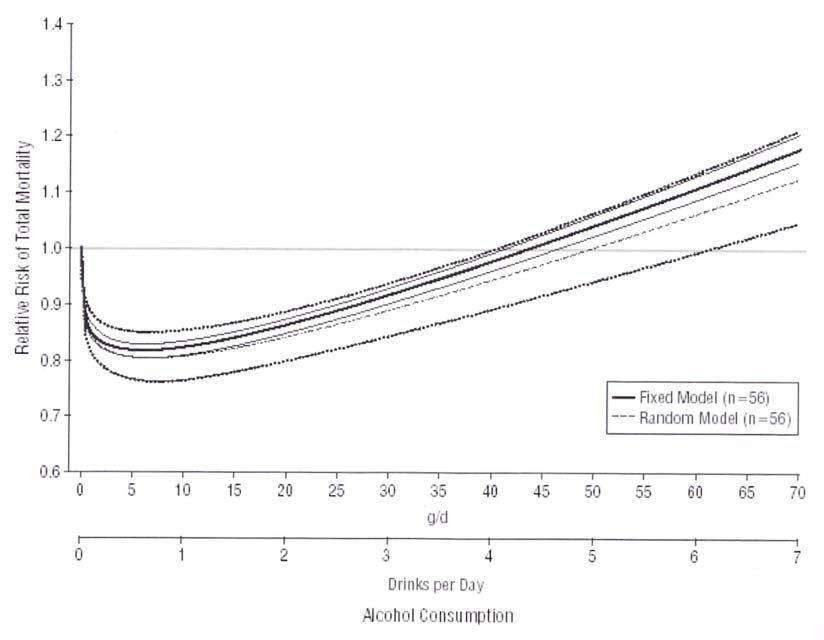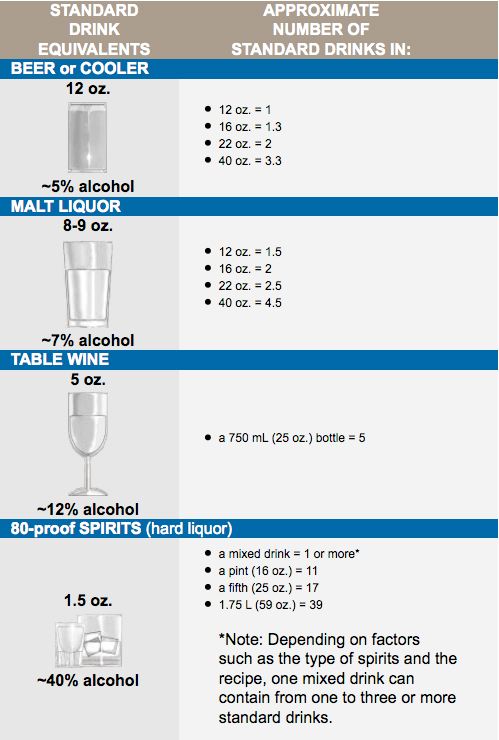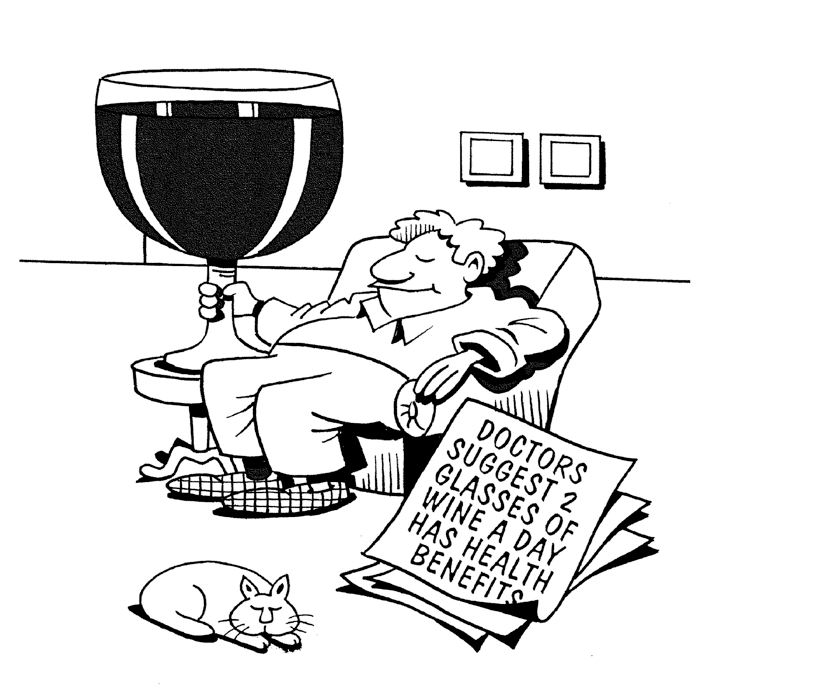The Debate as to the Health Benefits of Wine Continues in 2011
“Alcohol makes breast cancer more likely but cuts heart attack risk.
It could drive one to drink.”
Jill U. Adams, Los Angeles Times, 2011
The heated argument as to the health benefits of wine and other beverage alcohol as part of a healthy lifestyle
continued in 2011. A focus of the controversy in 2011 was breast cancer as new studies were reported
confirming a long-suspected link between some forms of breast cancer and alcohol. Unfortunately, selected
press releases sensationalized the research results causing some unjustified panic. The concern among
women was heightened by publications that failed to present the implications of the research accurately. With
little access to or inadequate understanding of the research findings, women were left to wonder what to do.
I can sympathize with the public’s confusion. As a medical doctor, I have read all the medical literature and
research on the relationship between alcoholic beverages and health, yet I find it increasingly exasperating
trying to decipher the conflicting reports. Practically every published research study ends with the disclaimers
such as, “Further study is necessary,” “More research is needed to explain the results,” and “The results may
be explained by biases and confounding.” The word “suggestive” or the two words “interpret cautiously” are often
employed.

The uncertainty stems primarily from the fact that all the research to date has been performed either in vitro on
lower life forms (rats, yeast, worms), or in vivo with cohort and case-control analyses. There have been no
well-executed, randomized, double-blinded, intervention trials controlled for all confounding variables. As noted
American researcher Arthur L. Klatsky, M.D., has reported, “The major issue is residual confounding by diet,
smoking and other traits, problematic statistical modeling, and under estimation of drinking amount which lowers the apparent threshold of risk. The association of a behavioral trait such as alcohol drinking with a
health outcome in any study could be due to chance, due to bias (confounding), or causal. While a chance
relation is always possible, statistical evaluation can render the likelihood vanishingly small. The accepted
standard for elimination of confounding and establishment of likely causality is the double-blinded randomized
controlled trial. Problems in blinding and prescription of long-term behavior, plus the perceived risk of harmful
effects have so far precluded this type of long term study with chronic disease endpoints. As a result, the issue
of how well we can infer causality from observational data remains a formidable challenge. While even well
performed observational studies cannot completely exclude possible genetic or environmental predilections to
health outcomes....criteria exist that can establish a very high probability of causality in these data.”
Man has been consuming wine for over 10,000 years and the link between wine and health has been
recognized for over 5,000 years. The use of wine as a sedative, antiseptic and vehicle for other medicines was
described in the Old and New Testament: “Use a little wine for thy stomach’s sake and thy frequent infirmities,
St. Paul, Timothy 5:23. Hippocrates, the Father of Western Medicine, advocated the use of wine to treat
practically every illness he had identified. “Wine is fit for man in a wonderful way, provided that it is taken with
good sense by the sick as well as the healthy.” Another Greek physician, Pliny the Elder, described wine as a
medicine in “Naturalis Historia,” and said, “Nothing is more useful than wine for strengthening the body and
also more detrimental to our pleasures if moderation be lacking.” Paracelsus was a German physician in the
Middle Ages who is considered the father of modern pharmacology. He stressed the tonic value of wine and
invented the word alcohol. “Whether wine is nourishment, medicine or poison, is a matter of dosage.”
It is clear from the quotes of the ancients that they knew that there was a boundary between the health benefits
of wine and hazardous imbibing. The term, hormesis, applies here, meaning a biological phenomenon in which
the favorable effect of moderate dosage of a substance is toxic in higher doses.
Since the first report of the effect of moderate alcohol consumption and the relationship between alcohol intake
and mortality in 1926 by biologist and researcher Raymond Pearl (Alcohol and Longevity),
validation has come from Arthur Klatsky, M.D., and others through extensive epidemiological studies that a J-shaped curve
exists for the composite alcohol-total mortality relationship: abstinence is an adverse health risk, moderate
drinking enhances health and lengthens life, and excessive drinking is the most dangerous to health and life.
This curve also holds true for cardiovascular disease, some cancers, and cognitive dysfunction as well. The J-shaped
curve is widely accepted whenever health and alcohol consumption is debated.

In interpreting the graph above or any study on the relationship between alcoholic beverages and health, it is important to understand the
definition of “moderate drinking” which is frequently referenced in research articles. A few key definitions must
be understood. In the United States, a standard drink (or unit) contains 17.7 ml of ethanol (about 14 grams of
pure alcohol) which is equivalent to 12 ounces of beer (about 5% alcohol), 5 ounces of table wine (about 12%
alcohol) and a shot of 80-proof distilled spirits (about 40% alcohol). A full bottle of wine (750 ml) contains about
5 to 7 drinks depending on the alcohol percentage. To determine the number of standard drinks in a bottle of
wine, multiple 750 ml by the alcohol percentage and divide by 17.7.

It is important to note that many drinkers do not understand the concept of a standard drink and according to
an article in Current Drug Abuse Review (2008), they often believe a standard drink is of greater volume than it
is. This is termed the “over-sizing effect” and leads to a false sense of drinking within the confines of
moderation. According to BBC News (October 7, 2011), the Office of National Statistics in the UK found that
82% of adults claim to know what a unit of alcohol is, but 77% don’t know how many units are in a typical large
glass of wine and only 13% kept a check on the number of units they drank.

Moderate drinking is defined in the Dietary Guidelines for Americans as no more than 1 standard drink per day
for women and no more than 2 standard drinks per day for men. This definition is referring to the amount
consumed on any single day and is not intended as an average over several days. A bottle of 16% alcohol
wine will contain 6.8 drinks or about 1 more drink than a bottle with 13% alcohol indicating alcohol percentage in
wine does make a difference when you are looking to drink in moderation. Obviously, one would want to scale
back the volume of drinking when imbibing a wine with a higher alcohol percentage or reach for a lower alcohol
wine to insure that you are drinking moderately.
Michael Apstein, M.D. in a report to SFGate.com (August 7, 2011) emphasized that the alcoholic content of
wine can make a big difference. He published a table showing the blood alcohol concentration (BAC) for an
average 130-pound woman who consumes two 5-ounce glasses of wine over 1.5 hours. The results were: 12%
(0.065% BAC), 13% (0.073% BAC), 14% (0.081% BAC), and 15% (0.088% BAC). As the alcohol content of
the wine rose 25% (from 12% to 15%), the BAC went up 35% to above the legal California driving limit of
0.08%. Refer to the blood alcohol calculator at www.globalrph.com.
Perhaps the most important well-publicized verification of the health benefits of wine came this year when a
new study by the United States Centers for Disease Control and Prevention (CDC) showed that moderate
alcohol consumption was one of four “low-risk lifestyle behaviors” that can reduce mortality significantly.
People who practiced the four behaviors (never smoking, eating a healthy diet, getting adequate exercise, and
consuming alcohol in moderation) studied in the National Health and Nutrition Examination Survey III mortality
study had a 63 percent less mortality rate than people who did not participate in the four behaviors. Both
abstention from alcohol and heavy drinking raised mortality rates. People who practiced any of the lifestyle
behaviors alone had a significant reduced mortality, but moderate alcohol use had a larger effect than either
diet or physical activity, and the greatest benefit was accrued when moderate alcohol consumption was
combined with the other three behaviors.
Despite the significance of the government’s admission that alcohol in moderation is healthy, there were no
recommendations offered for drinking. Although the revised 2010 Dietary Guidelines for Americans includes
information on the benefits of moderate drinking, neither the United States government nor most medical
professionals currently advise abstainers to begin drinking for health reasons. That said, if there are no
contraindications to drinking alcohol, light-to-moderate wine drinking is considered a healthy habit. There is
absolutely no added health benefit to drinking more than moderate amounts of wine daily.
It cannot be overemphasized that the moderate intake of wine by itself is not a health panacea. Regular
exercise and weight control are also important as part of a healthy lifestyle. If wine is consumed, it should be
drank regularly with meals and the meals should include non-starchy vegetables and low glycemic index fruits,
whole-grain foods, fish, lean meats, low-fat diary products, limited portions of saturated, trans-fat and
cholesterol and high levels of fats from fish and vegetable oils, and minimal salt intake. Smoking should be avoided.
A study published in the journal PLoS Medicine (October 2011) found that a healthy diet rich in raw fruits and
vegetables was able to mitigate the risk of cardiovascular disease and heart attack conferred by the DNA
sequence variation on chromosome 9p21. The authors of the study noted, “This is eye-opening because it
says that even if you have a predisposition to a disease, lifestyle makes a big difference. The effect can be
overcome by having a good diet.”
Another study that appeared in the Archives of Internal Medicine conducted by the National Institutes of Health and
AARP found important health benefits for dietary fiber. Men and women who ate the highest amount of fiber
were 22 percent less likely to die from any cause compared to those who ate the lowest amount. Fiber was
linked to a lower risk of cancer deaths in men but not women (men are more likely to die from cancers related
to diet such as esophageal cancer), with the strongest benefit from diets high in fiber from grains as opposed to
fruits, vegetables and beans. Fiber is thought to improve cholesterol levels, reduce inflammation and decrease
blood sugar levels.
The frequency of moderate drinking seems to matter. Many knowledgeable researchers recommend a daily
glass of wine with dinner, but a report in the BBC News (January 6, 2012) detailed a report by the UK
Commons Science and Technology Committee that suggests two to three alcohol free days a week. The
recommendation was based on data indicating an increased risk of liver disease for those who drank daily or
near daily compared with those who drank periodically.
The proposed health benefits of wine are thought to result from the combined effects of alcohol and
polyphenols found in the skin and seeds of red grapes. Although many studies suggest it is the polyphenols in
wine that give it superior health benefits compared to other alcoholic beverages, this has not been completely
proven. Arthur Klatsky, M.D., is considered an authority on wine and health, and he believes it is a scientifically
verified truth that wine drinkers are more protected from cardiovascular disease with most of this protection
coming from alcohol. He states that death from cardiovascular disease is lowest among red wine drinkers,
followed by beer drinkers and spirits drinkers.
However, a study by Italian researchers recently published in the European Journal of Epidemiology
(November 2011), analyzed about 16 case studies and articles, and found that moderate and regular drinking
was good for heart health, but a glass of red wine and a pint of beer (which both contain equivalent amounts of
alcohol) were linked equally to good cholesterol and protection against heart disease. Moderate beer and wine
consumption reduced the risk of heart disease with maximum protection advantage of 33% at a level of approximately 2
drinks per day by US standards. They found the risk curves (J-shaped relationships) for the two beverages
closely overlapped with the risk of cardiovascular disease increasing with increased consumption of either
beverage. A J-shaped association was not found for spirits but the pattern of drinking was not included as a
confounder in the analyses and spirits drinkers may have different drinking patterns.
Another relevant study appeared recently in the Journal of Studies on Alcohol and Drugs (January 2012) titled
“Wine Consumption and 20-year Mortality Among Late-Life Moderate Drinkers.” This study examined the level
of wine consumption and total mortality among older adults ages 55-65 at baseline, controlling for important
sociodemographic, behavioral, and health status factors. After adjusting for all co-variates, both high-wineconsumption
and low-wine-consumption moderate drinkers showed reduced mortality risks compared with
abstainers. Those for whom a low proportion of ethanol came from wine showed a substantially increased 20-
year mortality risk of 85%. After controlling for all co-variates, the mortality difference associated with wine
consumption was not significant. There are weaknesses in this study (see www.bu.edu/alcohol-forum/
critique-065), but it did point out the significant differences in lifestyle habits between low-wine and high-wine
groups. Many others have attributed the proposed superior health benefits of wine over other alcoholic
beverages to the lifestyle of wine drinkers who often have a higher levels of education and income, a better
diet, exercise more frequently, smoke less and overall are healthier.
Alcohol contributes its health benefits through many actions including stimulating the liver to produce HDL
(good cholesterol), inhibiting blood clotting and blood vessel inflammation, and extracting polyphenols during
fermentation. The polyphenols have many proposed beneficial actions that are very complex and poorly
understood at this time. The effects on the cardiovascular system alone are numerous, but the beneficial
effects reach beyond cardioprotection to include reduction in carcinogenesis, improved cognitive function,
favorable metabolic changes and a number of other health-enhancing effects. It is thought that red wine
polyphenols (such as resveratrol, quercetin, lutein, catechins and melatonin) interact with potentially thousands
of other wine compounds to produce a wide array of health benefits.
The United States has overtaken Italy and France and now leads the world in volume of wine consumed
according to the latest figures from Vinexpo reported in The Drinks Business.com (January 11, 2012).
Appropriate education of the public about regular, moderate and responsible drinking of wine could
dramatically affect the health of this country. It is estimated that 71 million Americans have cardiovascular
disease, or 1 in 3, and cardiovascular disease is our country’s number one killer. In a small way, perhaps this
article will contribute much needed education.
In the following pages, I will summarize peer-reviewed, scientific studies published in 2011 and very early in
2012 that contribute to our current understanding of the roles that alcohol and particularly wine play in our
health. In many cases I have not included the exact publication link since many of these scientific articles are
available only to paid subscribers. For those wishing to seek out the articles in their entirety, please visit
PubMed which comprises more than 21 million citations for biomedical literature from MEDLINE, life science
journals and online books (www.pubmed.gov). A recent listing of relevant medical articles on alcohol and health
can be found at www.french-paradox.net. An excellent current review of wine and health was published in December 2011 and is available online in the American Journal of Enology and Viticulture(www.ajevonline.org). For general and detailed information consult the websites of the US
National Institute on Alcohol Abuse and Alcoholism (www.niaaa.nih.gov), the US Centers for Disease Control
and Prevention (CDC) (www.cdc.gov/alcohol/), the UK National Health Service (www.nhs.uk/), and the US
Department of Agriculture dietary guidelines (www.cnpp.usda.gov).
Valuable critiques of currently published papers is now being provided by members of the International
Science Forum on Alcohol Research, a joint undertaking of the Institute on Lifestyle and Health of Boston
University of Medicine and Alcohol in Moderation (AIM) of the United Kingdom. Its co-directors are R. Curtis
Ellison, M.D., Professor of Medicine and Public Health, Boston University School of Medicine, and Helena
Conibear, Executive Director, Alcohol in Moderation (AIM), UK. The forum consists of an international group of
invited physicians and scientists who are specialists in their fields and committed to balanced and well
researched analysis regarding alcohol and health. The forum provides on its open website timely critiques and
comments by Forum members on emerging scientific publications and policy statements related to alcohol and
health, and provide an opportunity for all to seek expert opinion on topics related to alcohol and health.
Visit www.bu.edu/alcohol-forum/.
It has been recently reported that a University of Connecticut Health Center researcher has been accused of
falsifying data published in eleven scientific journals that have been widely cited in the general media. The red-wine
researcher, Dipak K. Das, was reported to have falsified data in 26 journal articles. The exact studies that are
implicated have not been reported to the public yet. This disturbing accusation may call into question some
research on the health benefits of resveratrol and anthocyanidins, but represents only a tiny fraction of studies
that have been published.
Readers should keep themselves informed by reading important scientific publications and policy statements regularly, as well as be
advised to follow the lifestyle, diet and drinking advice of their doctors.